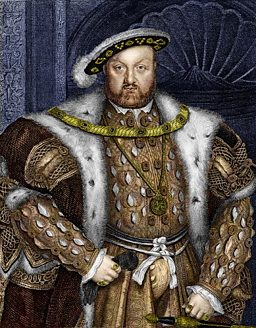Eight things you never knew about Henry VIII’s Christmas
Tudor Christmas was a time for revelry and fun. Henry VIII and his court celebrated the full 12 days of Christmas in excess, with tables ladened with roast swan, suckling pig and venison pasties, among other delights. He loved to dress up and tease his wives, as well as take part in festive games.
In this episode of Dan Snow's History Hit, Dan travels to what was once the heart of Henry's court, Hampton Court Palace, to meet with Historic Royal Palaces chief curator Tracy Borman and Richard Fitch of the Historic Kitchens Team, to discover how the Tudors celebrated and what of their traditions we still have today.
Here are eight things we learned from from this episode of Dan's “Origins of Christmas” series.
1. The yule log was the centrepiece of Tudor Christmas.
Henry VIII liked to spend Christmas at Hampton Court, which was adorned with decorations and greenery, such as holly and ivy. But most important of all was the yule log – a huge hunk of wood that remained lit throughout all 12 days of Christmas.
2. The Tudors had “Captain Christmas”.
He was, of course, a precursor to Father Christmas. While you might assume most of our Christmas traditions have Victorian origins, the Tudor links are strong. For example, singing carols, the mistletoe and some of the food, such as turkey, mince pies, and brussels sprouts, were all enjoyed during the Tudor period.
3. Their celebrations lasted not one, but 12 days.
Whereas British Christmas celebrations focus on the 25th December (with perhaps a few leftovers on Boxing Day) the Tudors’ didn’t let up: they celebrated all 12 days of Christmas with equal revelry. Advent was a time for fasting, so everyone was ready for parties and feasting by the time Christmas came around. They lasted until Epiphany, on 6th of January.
4. Henry VIII’s Christmas wasn’t cheap.
In his first Christmas in 1509, the king spent the equivalent of over £13 million. He wanted to make a statement after his father, Henry VII, had been considered a miser during his reign.
5. Tudor Christmas meals were served in three courses.
But those courses all contained a mix of sweet and savory dishes, with no rules as to how you mix and match them. These were shared across the banquet table. Here, you were expected to reach for the dishes facing you, and to eat from your side of the serving bowl. You were also supposed to loosen your belt before sitting down, for ease of comfort – and to avoid the embarrassment of sitting there groaning halfway through the meal.
6. The Tudor court’s favourite tipple was wine.
It mainly came from France, Italy, Germany and Cyprus, and arrived not in bottles but in large casks. This means it probably didn’t taste as good as our wine does today. The wine soon started to turn to vinegar once it was opened, meaning it had to be consumed quickly, or syrups, sugar, and water had to be added. Beer was a fashionable new drink at the time, while ale was a more common beverage outside the court.
7. Around half of Henry’s court worked in the kitchens.
There was an average of about 450 people within the court during Henry’s reign. Around 200 of them worked within the kitchens. In Hampton Court, there is about 110 linear meters of kitchen space – around a quarter of the ground floor.
8. Christmas Day was a religious day.
The 25th was not a major feasting time – that was reserved for Epiphany. For the Tudors, Christmas Day was all about going to church or chapel, listening to services, and sharing with those less fortunate at court. They provided excess so that it could be donated to the poor at the gates, or given to people from the surrounding areas who dined at the very bottom end of the hall. These were religious acts of charity – albeit performative ones.
To hear more about Tudor Christmas, listen to Dan Snow’s History Hit on Βι¶ΉΤΌΕΔ Sounds.


-
![]()
After Dark: Myths, Misdeeds & the Paranormal
The podcast that unpicks history’s spookiest, strangest, and most sinister stories.
-
![]()
History's Youngest Heroes
Nicola Coughlan and Helena Bonham Carter shine a light on extraordinary people from history.
-
![]()
The Curious History of Your Βι¶ΉΤΌΕΔ
Discover the extraordinary history of ordinary items all around you.
-
![]()
Sherlock Holmes Short Stories
This Christmas, listen to Sherlock Holmes Short Stories, narrated by Hugh Bonneville.





